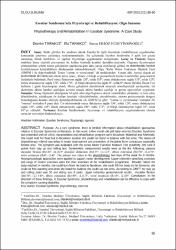| dc.contributor.author | Tarakçı, Devrim | |
| dc.contributor.author | Tarakçı, Ela | |
| dc.contributor.author | Hüseyinsinoğlu Ersöz, Burcu | |
| dc.date.accessioned | 08.07.201910:49:13 | |
| dc.date.accessioned | 2019-07-08T20:18:49Z | |
| dc.date.available | 08.07.201910:49:13 | |
| dc.date.available | 2019-07-08T20:18:49Z | |
| dc.date.issued | 2015 | en_US |
| dc.identifier.citation | Tarakçı, D., Tarakçı, E. ve Hüseyinsinoğlu Ersöz, B. (2015). Escobar sendromu'nda fizyoterapi ve rehabilitasyon: Olgu sunumu. Sağlık Bilimleri ve Meslekleri Dergisi, 2(1), 86-90. | en_US |
| dc.identifier.issn | 2148-7588 | |
| dc.identifier.uri | https://hdl.handle.net/20.500.12511/498 | |
| dc.description.abstract | Amaç: Nadir görülen bir sendrom olarak Escobar'la ilgili literatürde rehabilitasyon uygulamaları konusunda yeterince çalışmaya rastlanmamaktadır. Bu çalışmada Escobar Sendromlu 5 aylık kız çocuk sunulmuş, klinik özellikleri ve yapılan fizyoterapi uygulamaları tartışılmıştır. Gereç ve Yöntem: Başını tutabilen hasta yüzüstü pozisyonda ön kolları üzerinde kendini destekleyemiyordu. Olgunun fizyoterapiye yönlendirilme sebebi motor gelişiminin yaşıtlarına göre daha yavaş olabileceği görüşü ve eklemlerdeki hareket kısıtlılıklarının kontraktürlere dönüşmeden önlenebilmesiydi. Olgu "Kaba Motor Fonksiyon Ölçümü Testi (GMFM ) ile değerlendirildi. Testin "yatma ve yuvarlanma" alt maddesinden 8 puan aldı. Ayrıca olguda alt ekstremitede ileri derecede olmak üzere omuz , dirsek, el bileği ve parmaklarda hareket kısıtlılıkları gonyometrik ölçümlerle belirlendi. Pasif omuz fleksiyonu sağda 120º, solda 115º; omuz abduksiyonu sağda 135º, solda 125º; dirsek ekstansiyonu sağda 170º, solda 170º; el bileği ekstansiyonu sağda 0º, solda 0º olarak ölçüldü. Hasta 9 ay haftanın 2 günü fizyoterapiye alındı. Motor gelişimini desteklemek amacıyla nörofizyolojik yaklaşımlar, üst ekstremite eklem hareket açıklığını koruma amaçlı eklem hareket açıklığı ve germe egzersizleri uygulandı. Sonuçlar: Sonuç ölçümleri alındığında 14 aylık olan olgu bağımsız olarak sırtüstünden yüzüstüne ve tersi yöne dönebilmekte, yüzükoyun ön kolları üzerinde yükselebilmekte, oturabilmekte, oturma pozisyonunda dengesi bozulduğunda kendini elleriyle destekleyebilmekte idi. GMFM'ye göre "yatma ve yuvarlanma" testinden 30, "oturma" testinden 8 puan aldı. Üst ekstremitede omuz fleksiyonu sağda 130º, solda 120º; omuz abduksiyonu sağda 150º, solda 140º; dirsek ekstansiyonu sağda 180º, solda 175º; el bileği ekstansiyonu sağda 10º, solda 10º'ye yükseldi. Tartışma: Escobar Sendromunda fizyoterapi ve rehabilitasyon uygulamalarının olumlu sonuçlar vereceğini düşünmekteyiz. | en_US |
| dc.description.abstract | Purpose: As a rare syndrome, there is limited information about rehabilitation approaches relation to Escobar Syndrome in literature. In this work, a five month old girl baby who has Escobar Syndrome was presented and her clinic characteristics and rehabilitation program were discussed. Material and Methods: She could hold her head but in facedown position she could not stand in balance with her arms. The reason of physiotherapy referral was delay in motor development and prevention of the joints from contracture expecially limited ones. The symptom was evaluated with the Gross Motor Function Measure Test (GMFM). She took 8 points from stay up and rolling test. Goniometric measurement results were as the the following; passive shoulder flexion (R)120°, (L)115° shoulder abduction (R)135°, (L)125°, elbow extension (R)170°, (L)170°, wrist extension (R)0°, (L)0°. The patient was taken to the physiotherapy two days of the week for 9 months. Neurophysiologic approaches were applied to support motor development. Upper extremity stretching exercises and range of motion exercises were the other exercises of the rehabilitation programme. Results: When the baby reached 14 months, she could turn from her back to facedown, she could lift her body on her forearms, she could sit free standing and when she losed her balance she could use her arms. According to GMFT her stay up and rolling point was 30 and sitting was 8 point. Upper extremity goniometrical results: shoulder flexion (R)150°, (L) 140°, elbow extension (R)180°, (L)175°, wrist extension (R)10°, (L)10°. Conclusion: In the direction of those findings, in Escobar Syndrome, physiotherapy and rehabilitation can be effective to cope with the symptoms causing disability. | en_US |
| dc.language.iso | tur | en_US |
| dc.publisher | AVES | en_US |
| dc.rights | info:eu-repo/semantics/openAccess | en_US |
| dc.subject | Escobar Sendromu | en_US |
| dc.subject | Fizyoterapi | en_US |
| dc.subject | Egzersiz | en_US |
| dc.subject | Escobar Syndrome | en_US |
| dc.subject | Physiotherapy | en_US |
| dc.subject | Exercise | en_US |
| dc.title | Escobar Sendromu'nda fizyoterapi ve rehabilitasyon: Olgu sunumu | en_US |
| dc.title.alternative | Physiotherapy and rehabilitation In Escobar Syndrome: A case study | en_US |
| dc.type | article | en_US |
| dc.relation.ispartof | Sağlık Bilimleri ve Meslekleri Dergisi | en_US |
| dc.department | İstanbul Medipol Üniversitesi, Sağlık Bilimleri Fakültesi, Fizyoterapi ve Rehabilitasyon Bölümü | en_US |
| dc.authorid | 0000-0001-9804-368X | en_US |
| dc.identifier.volume | 2 | en_US |
| dc.identifier.issue | 1 | en_US |
| dc.identifier.startpage | 86 | en_US |
| dc.identifier.endpage | 90 | en_US |
| dc.relation.publicationcategory | Makale - Ulusal Hakemli Dergi - Kurum Öğretim Elemanı | en_US |


















